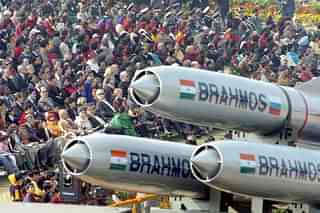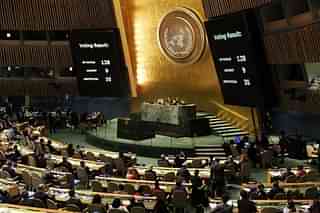Economy
Revdism Has Replaced Rowdyism As The New Menace In Indian Politics. Part II — The Economics
Banuchandar Nagarajan
Jan 06, 2024, 01:52 PM | Updated Jan 09, 2024, 01:37 PM IST
Save & read from anywhere!
Bookmark stories for easy access on any device or the Swarajya app.
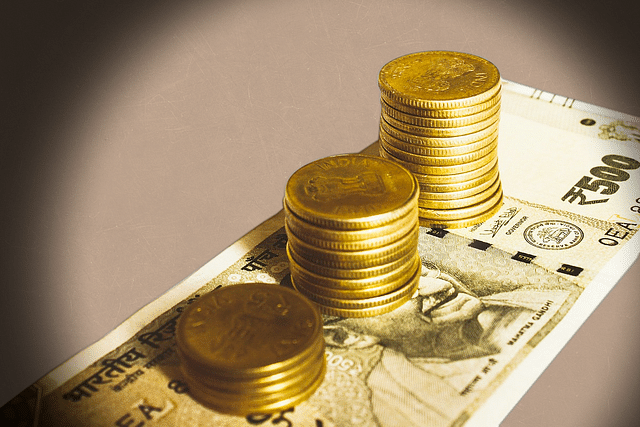
We have seen the political dimension of revdism in Part I of the series. Let us begin looking at the economics of the issue by getting a few numbers out of the way.
The Reserve Bank of India (RBI) report on state finances published last month has thrown up some alarming numbers. Look at the state debt-GSDP (gross state domestic product) of Punjab, Himachal Pradesh, and West Bengal in the table below. They are the top three large states for the last fiscal year. According to the Fiscal Responsibility and Budget Management (FRBM) Act, the target debt-GSDP ratio in any state should not exceed 20 per cent.


The all-India picture is shown in the map below.
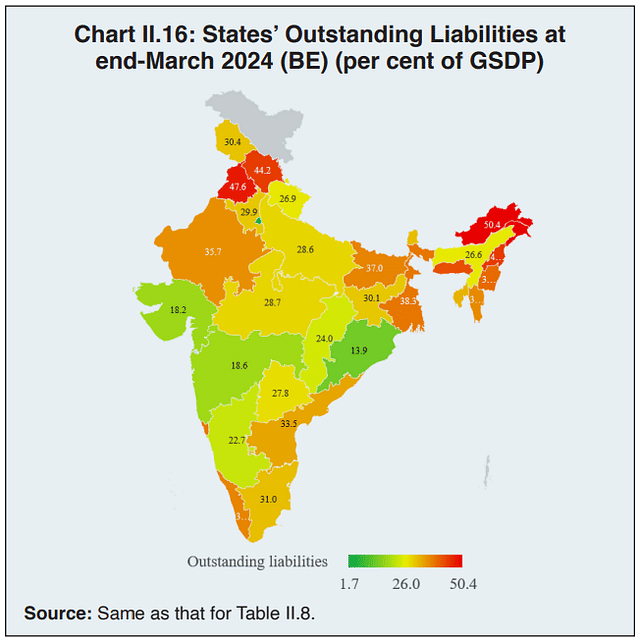
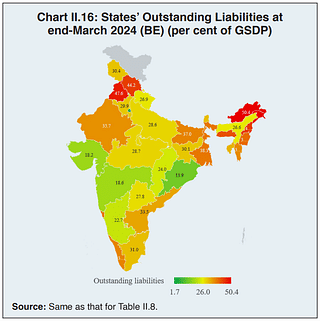
To the numbers above, we should add approximately another 10-15 percentage points to accommodate for state PSU (public sector undertaking) debt and guarantees.
Let us look at tax revenue spent on free schemes, as shown in the table below. Punjab gives away close to half of its revenue. The Bharatiya Janata Party (BJP)-ruled Madhya Pradesh gives away close to a third. How are these states hoping to invest in long-term prosperity?


Let us look at the all-India situation. The debt-GDP (gross domestic product) ratio for the Central government is 56 per cent, much higher than the FRBM-prescribed limit of 40 per cent. Some of the increase can be attributed to the Covid-19 pandemic response, but it is undeniably on the higher side. We also notice that there is a steady improvement in position when compared to FY (fiscal year) 2021.


The Finance Ministry has recently debunked the International Monetary Fund (IMF)’s "unfavourable case" assessment of our cumulative debt-GDP crossing 100 per cent in the near future. The corresponding projections by the IMF for the United States of America and China are at 160 per cent and 200 per cent, respectively.
Now, let us look at the impact on economic development in a few states. Consider Kerala, the favourite state of the "progressives." The Congress Member of Parliament (MP) from the state, Shashi Tharoor, recently posted on X that Kerala has run out of money for mid-day meals and is not making payments to pensioners, MNREGA workers, and KSRTC employees. Basically, the state is broke! But perniciously, Tharoor and "other brilliant minds" P Chidambaram, Raghuram Rajan, Jairam Ramesh, etc, bat for "Congress guarantees" in other states, which significantly increase the debt burden.
Punjab offers 300 units of free electricity. Ninety per cent of the households pay zero charges. The already existing free power to farmers had created negative externalities like depletion of the water table, environmental degradation, and stubble burning. This is the region that is water-surplus! It is hard to imagine that Punjab was at the forefront of our economic growth just a few decades ago. The state should be yearning for another Pratap Singh Kairon!
In Karnataka, the Deputy Chief Minister recently lamented the lack of funds for developmental works in constituencies. The Congress government is just seven months old in Karnataka, yet there is already a question mark on the progress of infrastructure projects in the state.
Tamil Nadu has the highest power sector debt in the country at Rs 1.34 lakh crore, as of March 2021. Successive governments have found it difficult to reverse the culture of subsidised power. Tamil Nadu is also an example of another state which is resting on past laurels. Chennai city has fallen behind even its South Indian counterparts in Bengaluru and Hyderabad in civic infrastructure.
Delhi does not feature in the above list of infamy for a reason. The revenue buoyancy of the state also being the national capital is hiding the mis-governance and profligacy. Free electricity, free water, and free travel in public transport for women by the Delhi government have burned its coffers. The promises made by the Aam Aadmi Party (AAP) before coming to power, such as building 20 new colleges, building 20,000 public toilets, installing 5 lakh CCTVs, creating 8 lakh jobs, etc, all remain pipe dreams due to poor fiscal management.
Delhi is the posterchild for lack of aspiration. The national capital of the fastest-growing large economy should be among the best cities in which to live in India. Unfortunately, that is not the case.
India is going to be the third-largest economy in the world soon. The state governments that attempt to improve productivity, by investing in infrastructure and skills, will gain from the virtuous gaze of the world on India. They should attempt to "Make in India" for the world and not fritter away the moment by shoddy fiscal management.
The "ascending" and "descending" states of the current economic cycle will depend solely on governance. The leading states of today will do well to not be complacent, and should watch out for Gujarat and Uttar Pradesh. Competition in the Amrit Kaal will create new winners and losers. Capital will move to where it can get better returns. It is forward-looking and does not care about history.
Also Read: Revdism Has Replaced Rowdyism As The New Menace In Indian Politics. Part I — The Politics
Save & read from anywhere!
Bookmark stories for easy access on any device or the Swarajya app.
Banuchandar is a political and public policy advisor. He posts at @Banu4Bharat.
Support Swarajya's 50 Ground Reports Project & Sponsor A Story
Every general election Swarajya does a 50 ground reports project.
Aimed only at serious readers and those who appreciate the nuances of political undercurrents, the project provides a sense of India's electoral landscape. As you know, these reports are produced after considerable investment of travel, time and effort on the ground.
This time too we've kicked off the project in style and have covered over 30 constituencies already. If you're someone who appreciates such work and have enjoyed our coverage please consider sponsoring a ground report for just Rs 2999 to Rs 19,999 - it goes a long way in helping us produce more quality reportage.
You can also back this project by becoming a subscriber for as little as Rs 999 - so do click on this links and choose a plan that suits you and back us.
Click below to contribute.



